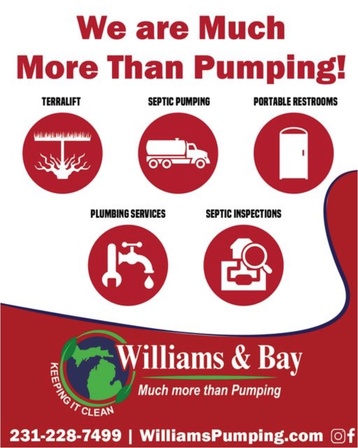
State Of The Lake: Inside Lake Leelanau's Productive Summer Battle Against Eurasian Watermilfoil
By Craig Manning | Aug. 30, 2023
Two steps forward, one step back: That old adage might just be the perfect way to encapsulate where things stand in the war the Lake Leelanau Lake Association (LLLA) has been waging against Eurasian watermilfoil (EWM), the extremely destructive invasive plant species first found in Lake Leelanau waters in 2019.
According to Annalise Povolo, who serves as director of administration and programs for the LLLA, the organization has had an immensely productive summer in combatting the growth and spread of EWM. But not everything is rosy – especially given the fact that recent climate change factors seem to be driving faster proliferation of EWM in Lake Leelanau and the waters of other infected lakes.
“We've heard from other lakes that their EWM also had a really good year,” Povolo tells The Ticker, noting that this past winter’s warm and mild weather proved extremely favorable for the growth of the invasive plant. In a typical winter, inland lakes like Lake Leelanau end up with cold waters and considerable ice and snow cover, which in turn starves invasive plants like EWM for light and forces them to go relatively dormant. Without a typical level of ice and snow cover, though, EWM “was able to grow more than normal throughout the winter,” Povolo says.
All that growth meant the LLLA was fighting a different war at the start of the 2023 season than it was last fall. At the conclusion of the 2022 field season, LLLA had hired a company called Zero Gravity Aerial to perform a full drone survey of Lake Leelanau. “This survey provided us with the precise locations of the EWM in the lake, from individual patches to large infestations,” Povolo wrote in a recent newsletter. “Using this information, we set out at the beginning of the [2023] season with a ‘plan of attack’ for our fight against EWM with an artillery of tools.”
But that plan wasn’t calibrated to the wintertime growth, and a second survey by Zero Gravity Aerial this past spring showed that the chessboard had shifted significantly during the offseason. There was more EWM in more places, making it clear to Povolo and her team that they were going to need to “kick it into high gear” and have an immensely productive summer to beat back the creeping presence of this invasive species.
Fighting EWM has become the top summer priority for EWM this decade. The invasive species was first identified in the south lake in 2019, and efforts at managing infested areas began in earnest during the spring/summer season in 2020. Those management efforts have grown each summer since, requiring more resources, more hands on deck, and more investment from LLLA and its supporters.
Per Povolo, though, that vigilance is essential to save Lake Leelanau from the damage that EWM could cause if allowed to run rampant. In her recent newsletter, Povolo wrote that the invasive plant “can grow up to the lake’s surface, choking out native plants and growing dense mats – making some highly infested areas impossible to swim in and drive boats through.”
The good news is that, while the LLLA may have lost a battle to EWM over the winter, the organization seems to be winning the war. Povolo reports that “two larger, previously treated sites” of EWM in Lake Leelanau are now completely free of the invasive plant, proving that it can be eliminated with the right tactics. She’s hopeful that this summer’s record-breaking efforts from the LLLA team and its many volunteers will show even more substantial gains come next season – even if the winter forces the organization to settle once more for a “two steps forward, one step back” outcome.
LLLA has been able to eliminate EWM by covering up infestations with large biodegradable burlap barriers. Those barriers – essentially big, sprawling burlap blankets – cover over the plant and starve it of sunlight, disrupting the photosynthesis process for long enough that the plants die off. As Povolo explained to the Leelanau Ticker last year, this approach works because EWM has not yet established a seed bank at the bottom of Lake Leelanau. In lakes with out-of-control EWM infestations, the plant has been allowed grow to the surface, where it flowers and produces seeds. Those seeds then sink to the bottom, establishing the kind of seed bank that can perpetuate EWM even if the plants themselves are killed off. In Lake Leelanau, native plants have seed banks but EWM doesn’t, which means that eliminating EWM infestations opens up those areas for native plants to grow back.
In 2022, Povolo says LLLA was able to set 2.2 acres of burlap over EWM infestations in Lake Leelanau – nearly 96,000 square feet. Already this year, the organization is up to over four acres of coverage, and Povolo anticipates that, “by the end of this season, we could almost double what we did last year.” Another drone survey this fall will offer some clarity on how much progress LLLA has made.
When asked how LLLA was able to have such a record-breaking summer of anti-EWM efforts, Povolo points to numerous factors. For one thing, favorable weather allowed crews to notch more days out on the lake. For another, a veritable army of volunteers came out to help with efforts this summer – including, on one day in July, more than 20 community members who assisted in laying down “1,200 feet of burlap, all in one line.”
A robust partnership with the Grand Traverse Band of Ottawa and Chippewa Indians has been extremely valuable as well, Povolo adds, as has the financial support from the Keller family, the local philanthropists who are funding LLLA’s “aquatic invasive species remediation control and prevention efforts” on a three-year basis, from 2022 to 2024.
That financial support meant LLLA this summer was “better equipped than we had ever been in previous years,” per Povolo, with three boats dedicated to EWM remediation, a full-time seasonal technician “to drive our boats and prepare materials,” more biologists on staff to lead the efforts, and more SCUBA divers “than we had ever employed” to take care of actually laying the burlap over the EWM infestations.
Povolo is hopeful that the LLLA will be able to hire even more divers to expand its EWM remediation efforts in future years – a goal that could be helped by the creation of a brand-new charitable foundation. That foundation, called Friends of Lake Leelanau, will eventually take the baton from the Keller family to fund LLLA’s fight against invasive species. Povolo tells the Leelanau Ticker that Friends of Lake Leelanau is currently setting up an endowment with the goal “to have it up and running by January 1 of 2025.”
“At that point, LLLA will apply for grants from Friends of Lake Leelanau, who would then award us the grants from the money that has been raised in that endowment,” Povolo explains.
CommentThe Latest Leelanau County Blotter & 911 Call Report
The Leelanau Ticker is back with a look at the most alarming, offbeat, or otherwise newsworthy calls …
Read More >>Top 8: Comeback Stories Were The Recurring Theme In Leelanau's Biggest News Of 2025
Don’t call it a comeback…except, maybe do! Returns and resurrections seemed to be the prevailing theme in …
Read More >>Property Watch: Bright and Cozy in Maple City
This brand new listing offers a smallish but updated home near Maple City.
"This well-kept 3-bedroom, 2-bath …
Read More >>Amazon Deliveries Provide Small Business Boost in Leelanau County
An online retailing behemoth that’s often criticized for putting the squeeze on small businesses is now providing …
Read More >>



